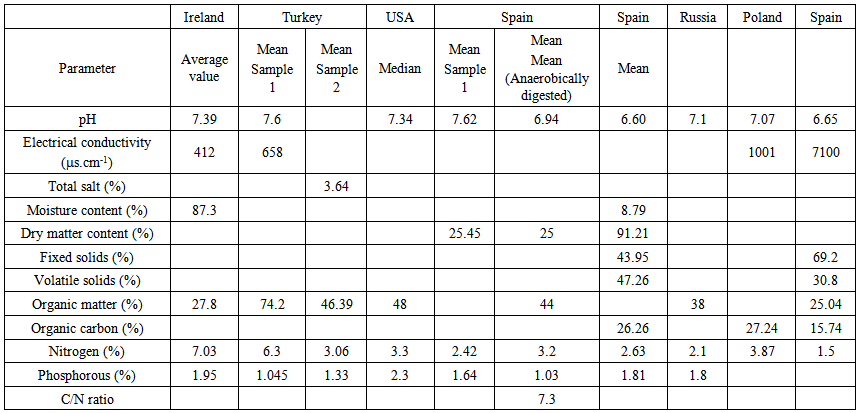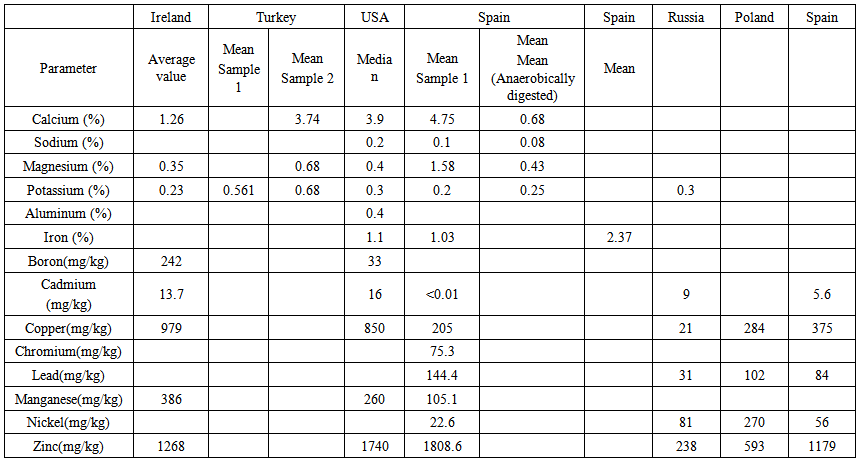-
Paper Information
- Next Paper
- Paper Submission
-
Journal Information
- About This Journal
- Editorial Board
- Current Issue
- Archive
- Author Guidelines
- Contact Us
Resources and Environment
p-ISSN: 2163-2618 e-ISSN: 2163-2634
2014; 4(4): 190-199
doi:10.5923/j.re.20140404.02
Characterization of Sewage Sludge Generated from Wastewater Treatment Plants in Swaziland in Relation to Agricultural Uses
Joseph S. Mtshali1, Ababu T. Tiruneh1, Amos O. Fadiran2
1Department of Environmental Health Science, University of Swaziland, P.O.Box 369, Mbabane, Swaziland
2Department of Chemistry, University of Swaziland, Private bag 04, Kwaluseni, Swaziland
Correspondence to: Ababu T. Tiruneh, Department of Environmental Health Science, University of Swaziland, P.O.Box 369, Mbabane, Swaziland.
| Email: |  |
Copyright © 2014 Scientific & Academic Publishing. All Rights Reserved.
Sewage sludge generated from wastewater treatment plants are being merited greater attention in light of their potential for improving soil properties and for providing important nutrient and trace element supplements that are essential for plant growth. Because of the differences in sludge characteristics among sludges that undergo different levels of treatment as well as the extensive and variable nature of pollutant inputs to wastewater, the fertilizer potential and pollutant risk of sewage sludge intended for agricultural application has to be specifically evaluated for each sludge. Sewage sludge generated from seven wastewater treatment plants in Swaziland were analysed for a range of physico-chemical characteristics including organic matter, nutrients, cation exchange capacity, pH and trace elements. Despite the differences in sludge processing and sludge storage ages, the sludge samples generally show high levels of organic matter, nutrients and trace elements needed for plant growth. The potential risk of heavy metal toxicity was evaluated by comparing the levels of heavy metals in the sludge samples with widely quoted and well known regulatory limits of a number of countries and the levels were found to be within acceptable risk level with respect to agricultural application. The research results indicate a positive outcome for the wastewater treatment plants in Swaziland that currently keep large piles of unused dried sludge within their premises.
Keywords: Sewage sludge, Nutrient value, Organic fertilizer, Soil amendment, Sludge reuse, Nitrogen, Phosphorus
Cite this paper: Joseph S. Mtshali, Ababu T. Tiruneh, Amos O. Fadiran, Characterization of Sewage Sludge Generated from Wastewater Treatment Plants in Swaziland in Relation to Agricultural Uses, Resources and Environment, Vol. 4 No. 4, 2014, pp. 190-199. doi: 10.5923/j.re.20140404.02.
Article Outline
1. Introduction
- Sewage sludge is known to be rich in nutrients (nitrogen and phosphorous), organic matter and trace elements that are beneficial for plant growth and better yield [58, 17]. Sewage sludge is also considered a suitable substitute for commercial fertilizers and the use of sewage sludge as a fertilizer decreases the requirement for commercial fertilizers [37]. Commercial fertilizers require large amount of phosphorous whereas phosphorous is known to be a limited resource [54]. Even though the nitrogen available in commercial fertilizers may not be a limited resource, the production of nitrogen fertilizers demand significant amount of energy [52]. The organic carbon in sludge amended soil can increase as far as three fold compared to inorganic fertilizer amended soils [40, 32]. Inorganic fertilizers usually reduce soil pH and increase the rate of soil acidification as well as increasing the percentage of aluminium saturation [36]. The decrease in pH of soils is traced possibly to the ammonium in the fertilizer [30]. In situations where sewage sludge may not contain the optimum nutrient ratio for growth, it can be combined with commercial fertilizers [33]. Application of sludge has been observed to improve the physico-chemical and biological properties of soils which in turn facilitates better growth of plants [1, 24]. Sludge increases the humus content of the soil [33]. The porosity, field capacity and wilting point all increase as a result of application of sewage sludge [7]. Organic matter which forms over half of the mass of sewage sludge also improves the physical condition of soils [18]. An increase in organic matter reduces the bulk density, increases aggregate stability, increases water holding capacity of soils and promotes greater water infiltration [21]. Organic matter also influences nutrient storage and turnover, soil biota and diversity as well as vulnerability to erosion, [5]. Infiltration capacity and air recirculation increase in fine textured soils as result of sludge application [12, 46]. By contrast, the increased bulk density of fine textured soils without sludge amendmet causes poor aeration which adversely affects plant growth [10].Macro elements are essential for plants and soil fauna [22]. Treated sewage sludge can enrich soil with macronutrients such as phosphorus, potassium, sulfur, calcium, magnesium and micro nutrients [62]. For example, a macro nutrient imbalance in the form of high exchangeable sodium percentage can cause nutritional disturbances in plants and impair the uptake of calcium [48]. Sodic soils are also known to have deficiencies in zinc and manganese [14].Exchangeable calcium is the major reserve of soil calcium available to plant roots [15]. Tomato and corn plants can be affected by deficiency in exchangeable calcium [6]. Field crop growth may also be affected by extractable magnesium [15]. Exchangeable forms of potassium are considered the primary source for plant uptake. Minimum adequate levels for exchangeable potassium of 40–80 mg/kg are recommended for crop growth [15]. Manganese deficiency occurs in some soils, due to oxidation of manganese when the pH is raised above 6.2. Manganese uptake in plants is, therefore, generally limited in alkaline soils [2, 13]. Acidic soils exhibit deficiencies in Ca, K, Mg, N, P, S and Mo and excess of Cu, Fe, Mn, Zn and Co as well as aluminium toxicity that limit conditions for crop development [53]. Sewage sludge, however, is deficient in potassium [33].Application of sewage sludge at higher rates also increases the cation exchange capacity, CEC, of soils [43]. The increase in CEC provides adsorption sites for essential nutrients within the root zone. An increase in the cation exchange capacity also helps in restricting the bioavailability of toxic heavy metals [21, 19]. The fauna and micro flora portions of soils are also altered after sewage addition [28]. According to Zaman, et al. [62], soil microbial biomass, carbon, nitrogen, carbon dioxide evolution, protease, deaminase, and urease activities become significantly higher in sludge composts than in chemical fertilizers treatments due to the greater availability of organic substrates which stimulate microbial activity. The biomass yields of plants grown on sludge amended soils have also been observed to increase. The shoot length, root length, biomass and total chlorophyll contents of plants increase with increasing rate of sewage sludge application [24]. Application of sewage sludge also has long term after effects on soil properties and crop yields except for sandy soils which may not be the case due to the increased aeration and faster decomposition of organic matter in sandy and loamy soils [33]. The pH of sewage sludge may vary between slightly acidic to neutral and alkaline ranges depending on the degree of treatment and application of sludge conditioners [61]. Sludge application may reduce the pH of soils due to humic acid release and may increase the electrical conductivity of soils [29]. However, acidic soils have been observed to experience increase in pH following sludge amendment [34, 60]. In addition the pH of soils may increase due to the exchangeable calcium and other cations present in sewage sludge [51]. The application of sewage sludge especially of high pH sludge to low pH soils has been observed to reduce the aluminum saturation in the interstitial complex, Al/IC, considerably [26]. Agricultural crops grow well when soil pH is between 6 and 7 because nutrients are available more at pH of around 6.5 [27, 41]. It is commonly recommended that soil pH should be maintained above 6.5 for sludge amended soils [16].Sewage sludge is a reliable source of nitrogen and phosphorous for plants. Nitrogen is an essential nutrient for plant growth since it is a constituent of all proteins and nucleic acids and therefore protoplasm [44]. Normally crop yield increases with increase in the application of sewage sludge and nitrogen is often the rate limiting factor in the application of sewage sludge to agricultural lands. The content of total nitrogen in sewage sludge reaches 40 – 50 kg/ton [33]. Anaerobic digestion process increases the total nitrogen concentration of sewage sludge. This is due to volume reduction because of the conversion of organic matter to gases and the resulting concentration of the remaining solids of which nitrogen is a part [45]. Only a small part of the total nitrogen is immediately available for plants after application of sewage sludge. In the course of mineralization of sewage sludge, nitrogen is transformed into available forms [33]. Sludge decomposition is reported to occur within 28 days [50]. The amount of nitrogen mineralized is inversely proportional to the carbon to nitrogen (C/N ratio). Soils with large C/N ratio result in low quantities of mineralized nitrogen [23]. Composting of sludge can also cause nitrogen immobilization [49]. Nitrate leaching to ground water as a result of sewage sludge application may be limited due to the limited nitrate form of nitrogen available and the loss of ammonia is mainly due to denitrification and immobilization [42]. Inorganic fertilizers, by contrast increase the C/N ratio which increases organic matter mineralization and nitrate leaching [57].Phosphorous is an essential nutrient needed for plant growth and is required in large quantities by plants while it is relatively immobile in soils. Phosphorous availability can be as high as 50% in the year of sewage sludge application [8]. Nyamangara and Mzezewa [32] reported that phosphorus increase in sludge amended soils was observed from the original 2-4 mg/kg of phosphorous in soil to 29-114 mg/kg of phosphorus in sludge amended soil. Soil phosphorous availability can be reduced in low pH soils in which the organic matter in the soil carries a positive charge attracting phosphorous and causing immobilization. Plantation growth in such low phosphorus environment leads to poor yield [26].The electrical conductivity of soils amended with sludge (with or without lime) also increases mainly due to the high level of salts present in sewage sludge. High salinity is also a factor that can inhibit plant growth in soils [38]. Soil characteristics such as pH, clay content, organic matter and moisture content are factors that influence the availability of heavy metals in plants by controlling metal speciation, binding of metals on surfaces (absorption-desorption), precipitation reactions and availability of metals in soil solution [11, 31]. Other properties such as cation exchange capacity and redox potential also affect plant uptake, solubility and mobility of heavy metals [43]. Sludge amendment with or without lime addition can provide extra buffering against soil acidity and reduce the inhibitory effects of sewage sludge especially on the availability of heavy metals [60]. Table A1 and A2 given in the Appendix at the end of this paper show the physical and chemical properties of sewage sludge as reported from a number of countries. The data shown in Table A1 and Table A2 display variability in sewage sludge characteristics in terms of the majority of the parameters indicated. For example the organic matter content shows range of variation between 25 and 50%. Nutrient and trace element availability as well as heavy metal contents with possible effect of toxicity also show variability. Sewage characteristics in general is location specific and the data in the tables reinforce the need for determining sewage sludge characteristics in order to assess the potential for reuse of sewage sludge in agriculture as well as for determining the risk that may be present as a result of heavy metal toxicity.This research had the objective of assessing the physico-chemical characteristics of sewage sludge generated from the various wastewater treatment plants in Swaziland, investigate their nutrient and agricultural potential and determine whether these sludges can be recommended as soil conditioner in agriculture as one viable and sustainable means of sludge disposal. The research also set out to establish the restriction that can be imposed on sewage sludge application for agriculture based on the heavy metal contents of the sludge.
2. Materials and Methods
- The methodology adopted in this research was quantitative and experimental. The research set up was designed with the objective of determining whether land application of dry sewage sludge generated from wastewater treatment plants in Swaziland can be recommended as soil conditioner in agriculture on the basis of their organic matter, nutrients and trace element contents. In addition the heavy metal concentrations in sludge were determined to ascertain the restriction that may have to be imposed on the dry sewage sludge in land application for agricultural uses. Laboratory experiments were carried out for the determination of physico-chemical properties of sewage sludge that best describes the nutrient and agricultural potential of sewage sludge. In addition, heavy metal determination were carried out for a a number of heavy metal elements that are known to have toxicity effects on humans, animals, plants and the soil ecological environment. For the purpose of determination of physico-chemical characteristics, sewage sludge samples were collected from seven wastewater treatment plants in Swaziland. The wastewater treatment processes that take place in each of the treatment plants sampled are given in Table 1.
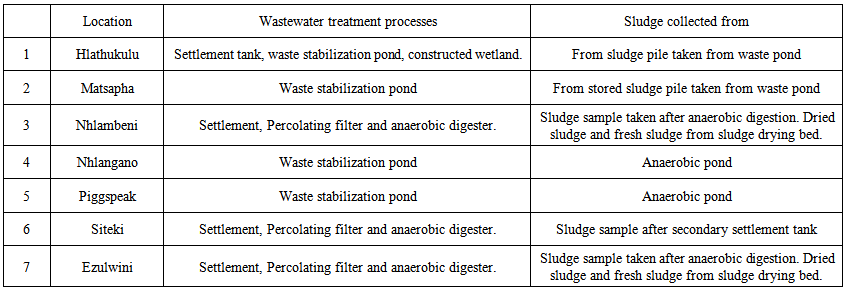 | Table 1. Wastewater treatment processes that take place at the seven wastewater treatment plants in Swaziland where sampling took place |
3. Results and Discussion
- The results of the analysis of sludge samples collected from the seven wastewater treatment plants in Swaziland are presented in Table 2, Table 3 and Table 4. The organic matter and nutrient contents were found mostly in high concentrations in the majority of sludge samples analyzed irrespective of the wastewater treatment types and the extent to which the sludge were stabilized. The organic matter content of the sludge samples varies in the range 20-60% with a median average of 46%. Sludge collected from anaerobically digested samples show approximately 50% organic matter despite the loss of organic matter by anaerobic digestion. With respect to organic matter, the sludge samples from Matsapha waste stabilization ponds show the lowest content of organic matter including low percentage of nitrogen. The sludge collected from the anaerobic pond of the Matsapha waste stabilization pond may have undergone through greater level of biodegradation because of the fact that the sludge has been retained in the pond for long time under wet (active) conditions before it is desludged. The cation exchange capacity values shown in Table 2 are generally high and application of these sludges to soil is expected to increase the cation exchange capacity of soils particularly of sandy and loamy soils that lack clay and thus have poor cation binding capacity. It is known that organic matter behave partially as amphoteric substance with the negative charge attracting cations and hence increasing the cation exchange capacity of sludge.
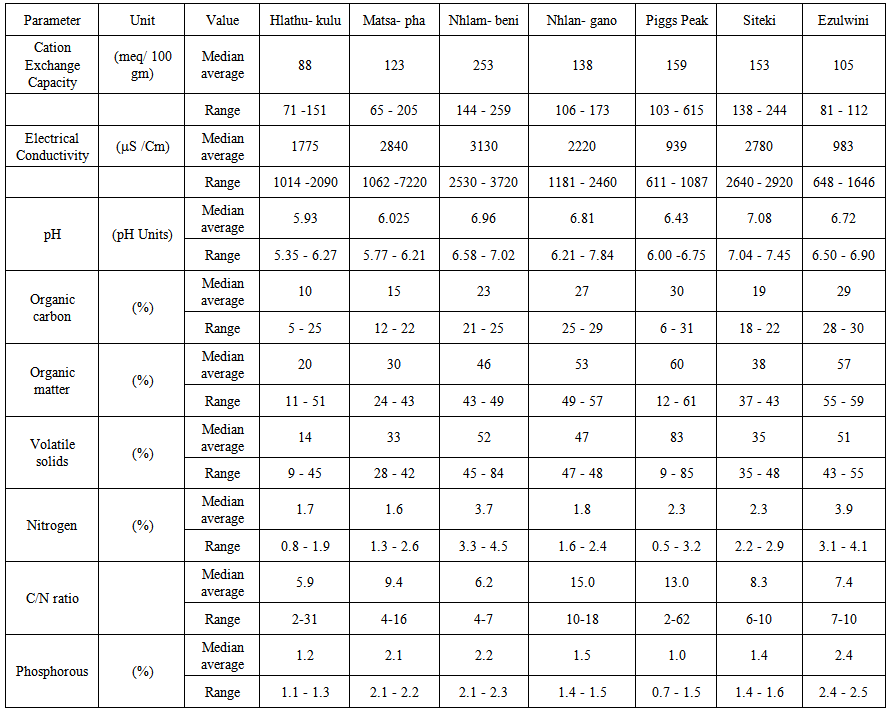 | Table 2. Physico-chemical characteristics of sludge samples collected from waste treatment plants in Swaziland |
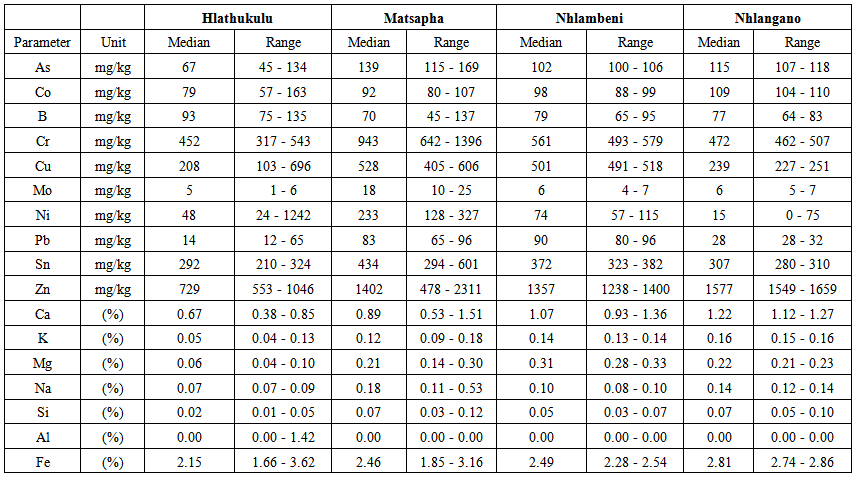 | Table 3. Macro and trace element concentrations characteristics of sludge samples collected from waste treatment plants in Swaziland |
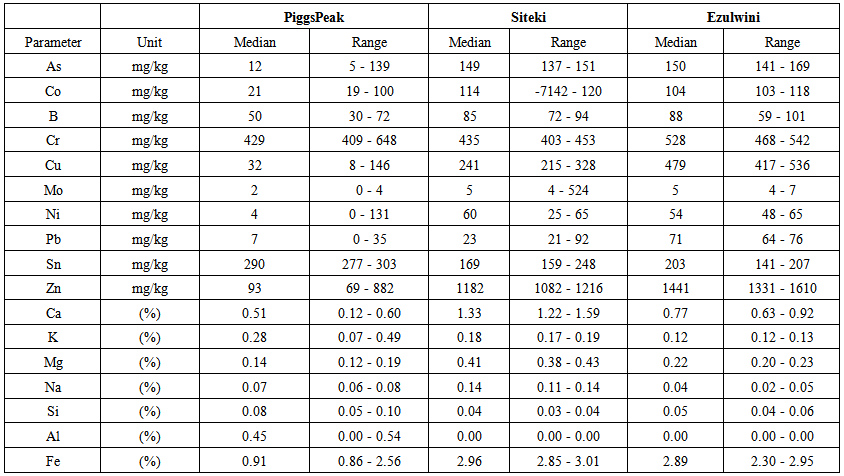 | Table 4. Macro and trace element concentrations characteristics of sludge samples collected from waste treatment plants in Swaziland |
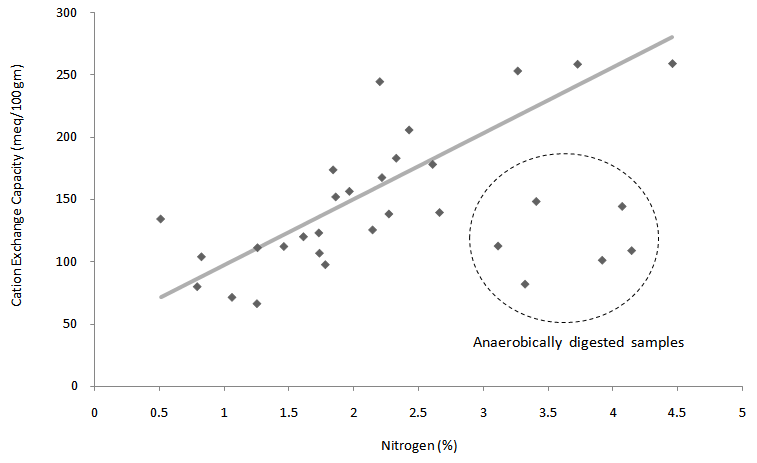 | Figure 1. Variation of nitrogen with cation exchange capacity in sludge samples |
4. Conclusions
- Characterization of sewage sludge is important before application sewage sludge to soil for agricultural purposes. Such characterization is helps determine the potential of sewage sludge for nutrient supplementation and for increasing plant yields. In addition the information will be useful for determining suitable rate of application of sewage sludge and for investigating pollutant risks that may be associated with the use of sewage sludge. The sludge samples taken from seven wastewater treatment plants in Swaziland were analyzed for a range of physico-chemical characteristics including nutrients, organic matter and trace elements. The organic matter contents were high in all of the sludge samples despite the fact that some of the dried sludge samples were stored over a period of ten years. Sludge samples that were kept for a long period of storage under wet conditions, such as the waste stabilization ponds, showed relatively lower contents of organic matter. The nutrient contents (nitrogen and phosphorous) were high in all of the sludge samples with the samples from the anaerobically digested sewage sludge containing the highest concentrations. Generally higher C/N ratios were recorded in the sludge samples which is an indication that there is limited mobilization of nitrogen by incorporation into cell mass which make the nitrogen contents available at a later period when it is needed most for plants during the period of growth. The high cation exchange capacities of the sludge samples were also evident with the nitrogen contents showing strong correlation with the sludge cation exchange capacities. This result is one positive outcome for application of sludge for agricultural purposes because such association of nitrogen with cation exchange capacity means slow release of nutrients (greater period of availability). In addition increase in cation exchange capacity results in reduced mobility of potentially toxic and inhibitory heavy metals. The pH of the sludge samples mostly fell in the range between 6 and 7. Further stabilization of the sludges may not be necessary for application to soils that are not too acidic or too alkaline, or unless it is indicated by further plant trials. The major trace metal concentrations were largely found to be below the regulatory limits specified in the South African, USA, EU regulations. The sludge samples, therefore, carry low risk of potential heavy metal toxicity with respect to agricultural uses. This positive result shall be examined further with future pilot trials of plants grown on sludge amended soils under different soil and plant conditions in Swaziland.
 Abstract
Abstract Reference
Reference Full-Text PDF
Full-Text PDF Full-text HTML
Full-text HTML